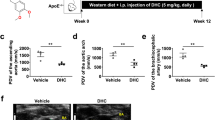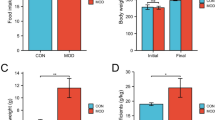Abstract
Objective
In present study, we employed cDNA-based microarray technique to investigate the effect of a synthetic LXR ligand T0901317 on hepatic gene expression of proinflammatory cytokines in apolipoprotein E knockout mice fed an atherogenic diet.
Methods and results
Male 8-week-old apoE−/− mice were randomly divided into four groups, baseline group, vehicle group, prevention group and treatment group. All of the mice were fed a high-fat/high-cholesterol diet with or without LXR agonist T0901317 for 8 or 14 weeks. Gene array analysis found 17 atherosclerosis-related genes with a 2- to 8-fold difference in expression level between vehicle-treated group and T0901317-treated group. It induced mRNA expression of proinflammatory cytokine tumor necrosis factor (TNF), but inhibited gene expression of several other proinflammatory cytokines including interleukin (IL)-1α, IL-6, and IL-7 in the liver. C-reactive protein, TNF, matrix metalloproteinase-9, IL-1α, IL-6, and IL-7 were verified by real-time quantitative PCR. Next, enzyme-linked immunosorbent assay analyses showed up-regulation of TNFα levels and down-regulation of IL-α, IL-6, IL-7 levels in plasma sample.
Conclusion
The synthetic LXR agonist T0901317 has paradoxical roles in hepatic gene expression of proinflammatory cytokines in apoE−/− mice.





Similar content being viewed by others
Abbreviations
- LXR:
-
liver X receptor
- apoE−/−:
-
apolipoprotein E knockout
- TNF:
-
tumor necrosis factor
- IL:
-
interleukin
- MMP:
-
matrix metalloproteinase
- CRP:
-
C-reactive protein
- ELISA:
-
enzyme-linked immunosorbent assay
- TG:
-
triglyceride
- TC:
-
total cholesterol
- HDL-C:
-
high density lipoprotein cholesterol
- Apo:
-
apolipoprotein
- INOS:
-
inducible nitric oxide synthase
- COX2:
-
cyclooxygenase 2
- LPS:
-
lipopolysaccharide
- GAPDH:
-
glyceraldehyde-3-phosphate dehydrogenase
- ABC:
-
ATP-binding cassette transporter
- ECM:
-
extracellular matrix
- 22(R)-HC:
-
22(R)-hydroxycholesterol
- 9cRA:
-
9-cis-retinoic acid
- GR:
-
glucocorticoid receptor
References
Libby, P. 2002. Inflammation in atherosclerosis. Nature 420:868–874.
Lusis, A. J. 2000. Atherosclerosis. Nature 407:233–241.
Glass, C. K., and J. L. Witztum. 2001. Atherosclerosis: the road ahead. Cell 104:503–516.
Zitzer, H., W. Wente, M. B. Brenner, S. Sewing, K. Buschard, J. Gromada, and A. M. Efanov. 2006. Sterol regulatory element-binding protein 1 mediates liver X receptor-beta-induced increases in insulin secretion and insulin messenger ribonucleic acid levels. Endocrinology 147:3898–3905.
Tang, C. K., G. H. Yi, J. H. Yang, L. S. Liu, Z. Wang, C. G. Ruan, and Y. Z. Yang. 2004. Oxidized LDL upregulated ATP binding cassette transporter A1 in THP-1 macrophages. Acta Pharmacol. Sin. 25(5):581–586.
Joseph, S. B., A. Castrillo, B. A. Laffitte, D. J. Mangelsdorf, and P. Tontonoz. 2003. Reciprocal regulation of inflammation and lipid metabolism by liver X receptors. Nat. Med. 9:213–219.
Castrillo, A., S. B. Joseph, C. Marathe, D. J. Mangelsdorf, P. Tontonoz. 2003. Liver X receptor-dependent repression of matrix metalloproteinase-9 expression in macrophages. J. Biol. Chem. 278:10443–10449.
Blaschke, F., Y. Takata, E. Caglayan, A. Collins, P. Tontonoz, W. A. Hsueh, and R. K. Tangirala. 2006. A nuclear receptor corepressor-dependent pathway mediates suppression of cytokine-induced C-reactive protein gene expression by liver X receptor. Circ. Res. 99:e88–e99.
Fowler, A. J., M. Y. Sheu, M. Schmuth, J. Kao, J. W. Fluhr, L. Rhein, J. L. Collins, T. M. Willson, D. J. Mangelsdorf, P. M. Elias, and K. R. Feingold. 2003. Liver X receptor activators display anti-inflammatory activity in irritant and allergic contact dermatitis models: liver-X-receptor-specific inhibition of inflammation and primary cytokine production. J. Invest. Dermatol. 120:246–255.
Terasaka, N., A. Hiroshima, A. Ariga, S. Honzumi, T. Koieyama, T. Inaba, and T. Fujiwara. 2005. Liver X receptor agonists inhibit tissue factor expression in macrophages. Febs J. 272:1546–1556.
Peet, D. J., S. D. Turley, W. Ma, B. A. Janowski, J. M. Lobaccaro, R. E. Hammer, and D. J. Mangelsdorf. 1998. Cholesterol and bile acid metabolism are impaired in mice lacking the nuclear oxysterol receptor LXR alpha. Cell 93:693–704.
Ratliff, E. P., A. Gutierrez, R. A. Davis. 2006. Transgenic expression of CYP7A1 in LDL receptor-deficient mice blocks diet-induced hypercholesterolemia. J. Lipid. Res. 47:1513–1520.
Joseph, S. B., E. McKilligin, L. Pei, M. A. Watson, A. R. Collins, B. A. Laffitte, M. Chen, G. Noh, J. Goodman, G. N. Hagger, J. Tran, T. K. Tippin, X. Wang, A. J. Lusis, W. A. Hsueh, R. E. Law, J. L. Collins, T. M. Willson, and P. Tontonoz. 2002. Synthetic LXR ligand inhibits the development of atherosclerosis in mice. Proc. Natl. Acad. Sci. U. S. A. 99:7604–7609.
Terasaka, N., A. Hiroshima, T. Koieyama, N. Ubukata, Y. Morikawa, D. Nakai, and T. Inaba. 2003. T-0901317, a synthetic liver X receptor ligand, inhibits development of atherosclerosis in LDL receptor-deficient mice. FEBS Lett. 536:6–11.
Lee, C. K., R. Weindruch, and T. A. Prolla. 2000. Gene-expression profile of the ageing brain in mice. Nat. Genet. 25:294–297.
Cao, S. X., J. M. Dhahbi, P. L. Mote, and S. R. Spindler. 2001. Genomic profiling of short- and long-term caloric restriction effects in the liver of aging mice. Proc. Natl. Acad. Sci. U. S. A. 98:10630–10635.
Levin, N., E. D. Bischoff, C. L. Daige, D. Thomas, C. T. Vu, R. A. Heyman, R. K. Tangirala, and I. G. Schulman. 2005. Macrophage liver X receptor is required for antiatherogenic activity of LXR agonists. Arterioscler. Thromb. Vasc. Biol. 25:135–142.
Marleau, S., D. Harb, K. Bujold, R. Avallone, K. Iken, Y. Wang, A. Demers, M. G. Sirois, M. Febbraio, R. L. Silverstein, A. Tremblay, and H. Ong. 2005. EP 80317, a ligand of the CD36 scavenger receptor, protects apolipoprotein E-deficient mice from developing atherosclerotic lesions. Faseb J. 19:1869–1871.
Hansson, G. K., P. Libby, U. Schonbeck, and Z. Q. Yan. 2002. Innate and adaptive immunity in the pathogenesis of atherosclerosis. Circ. Res. 91:281–291.
Libby, P, and Z. S. Galis. 1995. Cytokines regulate genes involved in atherogenesis. Ann. N. Y. Acad. Sci. 748:158–168; discussion 168–170.
Libby, P, P. M. Ridker, and A. Maseri. 2002. Inflammation and atherosclerosis. Circulation 105:1135–1143.
Recinos, A. 3rd, B. K. Carr, D. B. Bartos, I. Boldogh, J. R. Carmical, L. M. Belalcazar, and A. R. Brasier. 2004. Liver gene expression associated with diet and lesion development in atherosclerosis-prone mice: induction of components of alternative complement pathway. Physiol. Genomics 19:131–142.
Martinet, W, D. M. Schrijvers, G. R. De Meyer, J. Thielemans, M. W. Knaapen, A. G. Herman, and M. M. Kockx. 2002. Gene expression profiling of apoptosis-related genes in human atherosclerosis: upregulation of death-associated protein kinase. Arterioscler. Thromb. Vasc. Biol. 22:2023–2029.
Tracey, K. J., and A. Cerami. 1994. Tumor necrosis factor: a pleiotropic cytokine and therapeutic target. Annu. Rev. Med. 45:491–503.
Piecyk, M., S. Wax, A. R. Beck, N. Kedersha, M. Gupta, B. Maritim, S. Chen, C. Gueydan, V. Kruys, M. Streuli, and P. Anderson. 2000. TIA-1 is a translational silencer that selectively regulates the expression of TNF-alpha. Embo J. 19:4154–4163.
Dean, J. L., R. Wait, K. R. Mahtani, G. Sully, A. R. Clark, and J. Saklatvala. 2001. The 3′ untranslated region of tumor necrosis factor alpha mRNA is a target of the mRNA-stabilizing factor HuR. Mol. Cell. Biol. 21:721–730.
Shurety, W., A. Merino-Trigo, D. Brown, D. A. Hume, and J. L. Stow. 2000. Localization and post-Golgi trafficking of tumor necrosis factor-alpha in macrophages. J. Interferon Cytokine Res. 20:427–438.
Landis, M. S., H. V. Patel, and J. P. Capone. 2002. Oxysterol activators of liver X receptor and 9-cis-retinoic acid promote sequential steps in the synthesis and secretion of tumor necrosis factor-alpha from human monocytes. J. Biol. Chem. 277:4713–4721.
Galis, Z. S., C. Johnson, D. Godin, R. Magid, J. M. Shipley, R. M. Senior, and E. Ivan. 2002. Targeted disruption of the matrix metalloproteinase-9 gene impairs smooth muscle cell migration and geometrical arterial remodeling. Circ. Res. 91:852–859.
Galis, Z. S., G. K. Sukhova, R. Kranzhofer, S. Clark, and P. Libby. 1995. Macrophage foam cells from experimental atheroma constitutively produce matrix-degrading proteinases. Proc. Natl. Acad. Sci. U. S. A. 92:402–406.
Pasterkamp, G., A. H. Schoneveld, D. J. Hijnen, D. P. de Kleijn, H. Teepen, A. C. van der Wal, and C. Borst. 2000. Atherosclerotic arterial remodeling and the localization of macrophages and matrix metalloproteases 1, 2 and 9 in the human coronary artery. Atherosclerosis 150:245–253.
Kirii, H., T. Niwa, Y. Yamada, H. Wada, K. Saito, Y. Iwakura, M. Asano, H. Moriwaki, and M. Seishima. 2003. Lack of interleukin-1beta decreases the severity of atherosclerosis in ApoE-deficient mice. Arterioscler. Thromb. Vasc. Biol. 23:656–660.
Isoda, K., S. Sawada, N. Ishigami, T. Matsuki, K. Miyazaki, M. Kusuhara, Y. Iwakura, and F. Ohsuzu. 2004. Lack of interleukin-1 receptor antagonist modulates plaque composition in apolipoprotein E-deficient mice. Arterioscler. Thromb. Vasc. Biol. 24:1068–1073.
Blake, G. J., and P. M. Ridker. 2003. C-reactive protein and other inflammatory risk markers in acute coronary syndromes. J. Am. Coll. Cardiol. 41:37S–42S.
Aggarwal, S., and A. L. Gurney. 2002. IL-17: prototype member of an emerging cytokine family. J. Leukoc. Biol. 71:1–8.
Lee, J., W. H. Ho, M. Maruoka, R. T. Corpuz, D. T. Baldwin, J. S. Foster, A. D. Goddard, D. G. Yansura, R. L. Vandlen, W. I. Wood, and A. L. Gurney. 2001. IL-17E, a novel proinflammatory ligand for the IL-17 receptor homolog IL-17Rh1. J. Biol. Chem. 276:1660–1664.
Heinrich, P. C., J. V. Castell, and T. Andus. 1990. Interleukin-6 and the acute phase response. Biochem. J. 265:621–636.
Moshage, H. 1997. Cytokines and the hepatic acute phase response. J. Pathol. 181:257–266.
Karin, M., and L. Chang. 2001. AP-1-glucocorticoid receptor crosstalk taken to a higher level. J. Endocrinol. 169:447–451.
Herrlich, P. 2001. Cross-talk between glucocorticoid receptor and AP-1. Oncogene 20:2465–2475.
Nissen, R. M., and K. R. Yamamoto. 2000. The glucocorticoid receptor inhibits NFkappaB by interfering with serine-2 phosphorylation of the RNA polymerase II carboxy-terminal domain. Genes Dev. 14:2314–2329.
Acknowledgment
The authors gratefully acknowledge the financial support from the National Natural Sciences Foundation of China (30470720), Post-doctor Sciences Foundation of China (2005037157), and Hunan Provincial Natural Sciences Foundation of China (06jj5058).
Author information
Authors and Affiliations
Corresponding author
Rights and permissions
About this article
Cite this article
Dai, X., Ou, X., Hao, X. et al. Effect of T0901317 on Hepatic Proinflammatory Gene Expression in ApoE−/− Mice Fed a High-fat/high-cholesterol Diet. Inflammation 30, 105–117 (2007). https://doi.org/10.1007/s10753-007-9026-2
Received:
Accepted:
Published:
Issue Date:
DOI: https://doi.org/10.1007/s10753-007-9026-2




